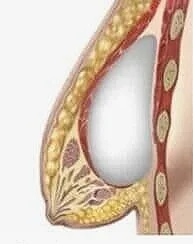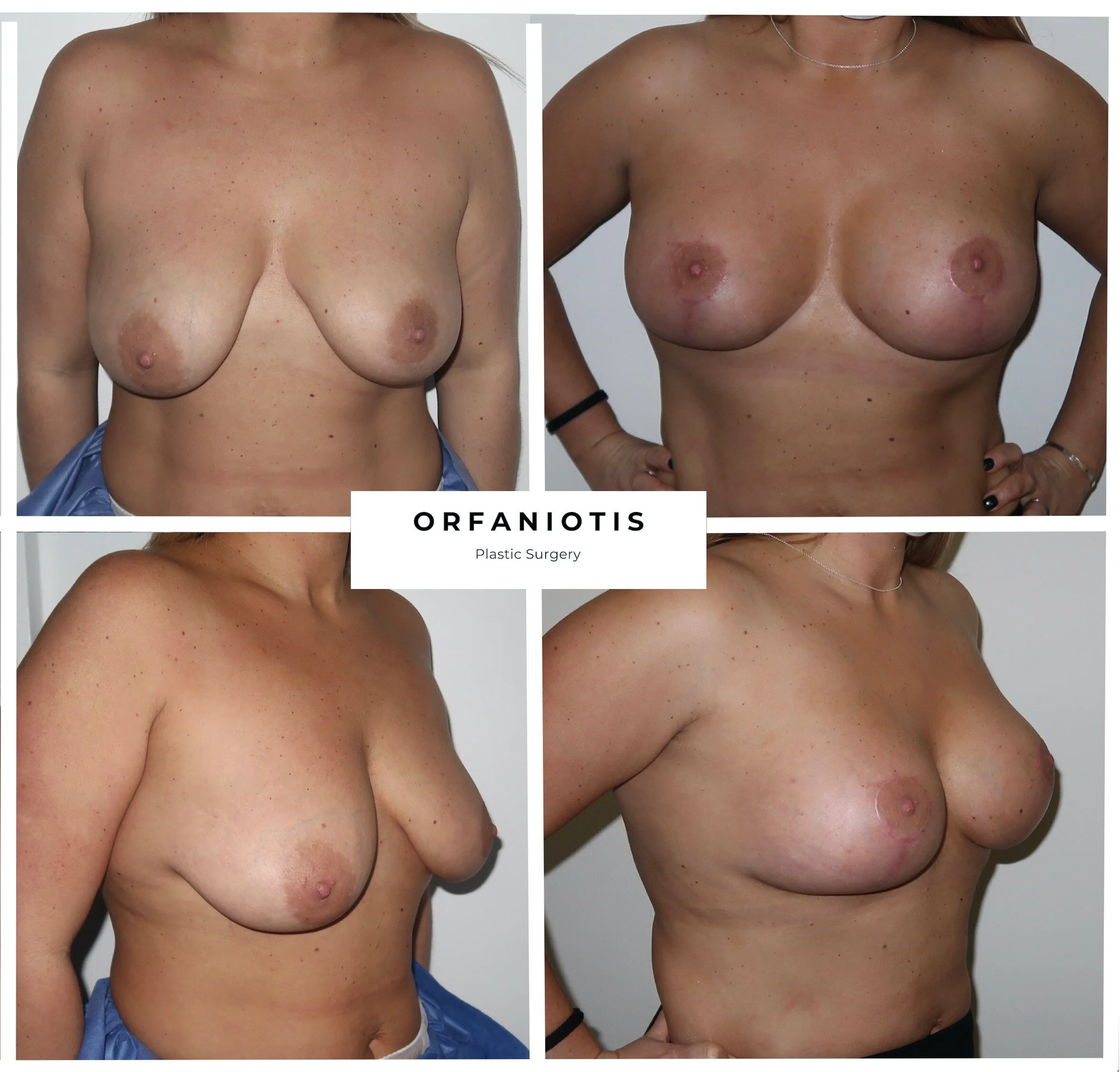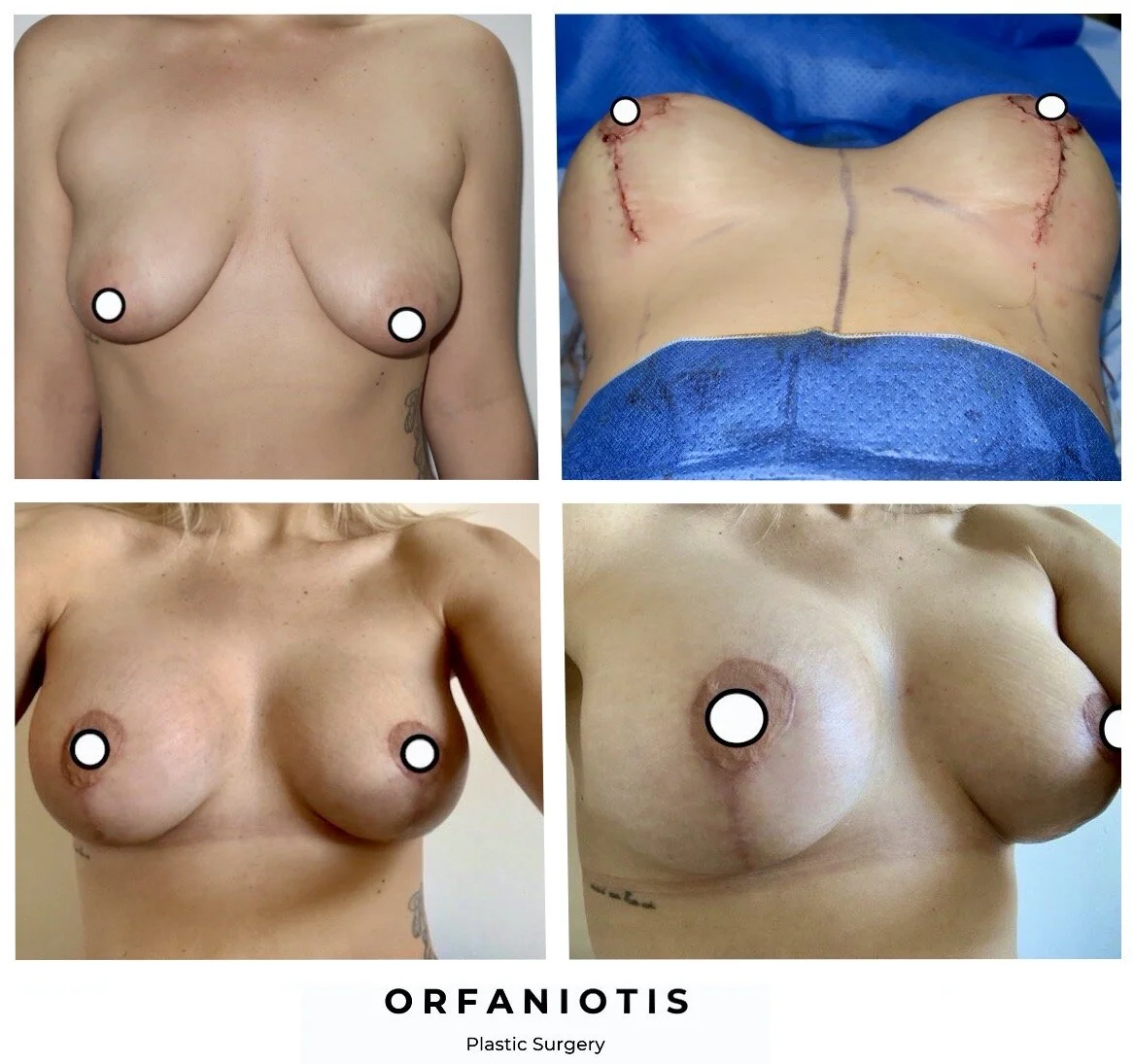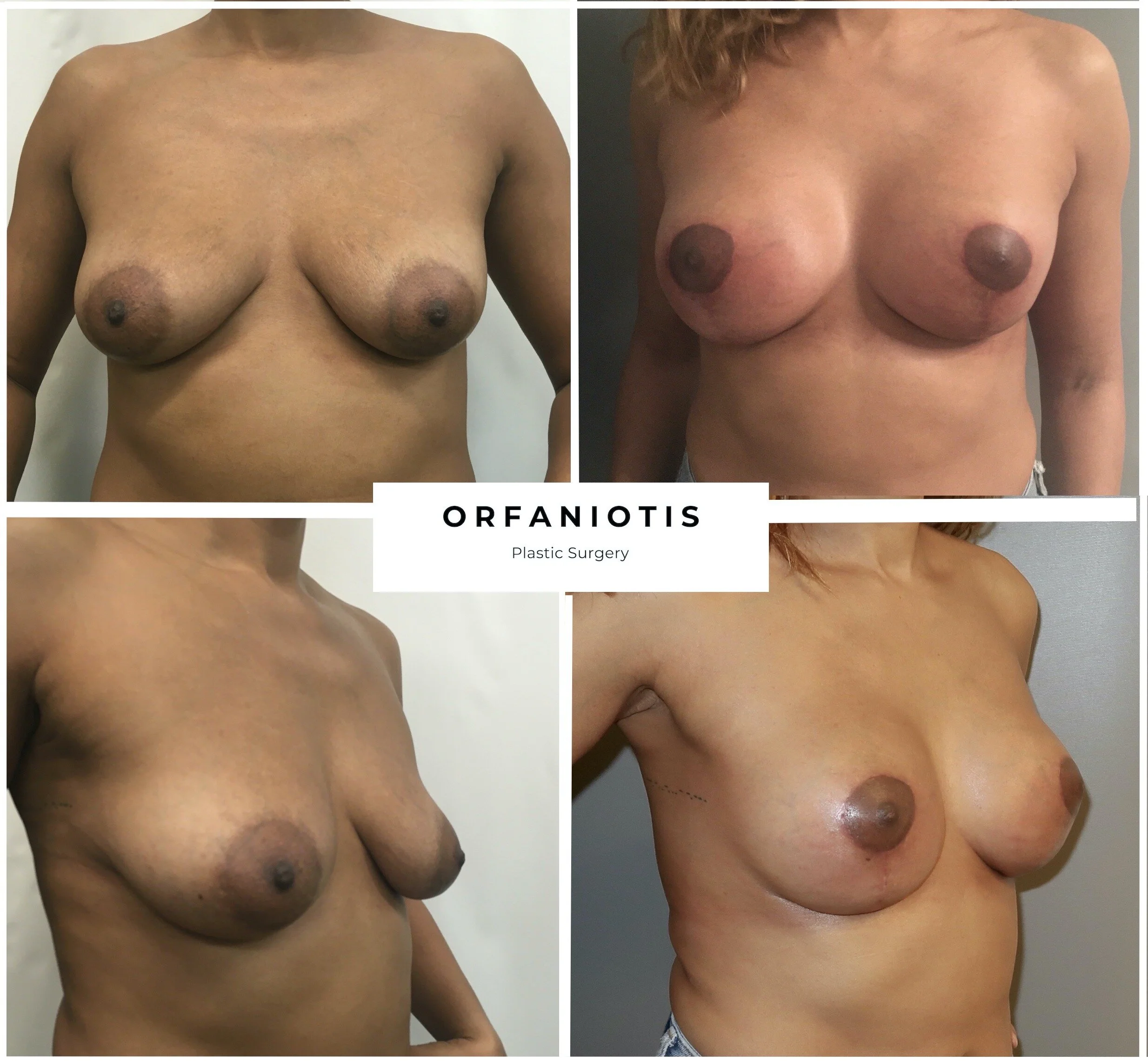Augmentation Mastopexy: When and why a breast uplift may be combined with breast implants?
Augmentation Mastopexy is a procedure that combines a breast uplift procedure with breast implants.
When is there a need to combine a breast uplift procedure with implants?
Augmentation Mastopexy is the ideal procedure for those women who are looking to increase breast volume but also address concerns with breast droopiness. It is a relatively complex breast operation, which aims to totally reshape the breast. The implants are used to enhance the volume, whilst the breast lift allows repositioning the breast tissue and nippe-areola complex into a higher position, as well as removing the excess skin.
It is not uncommon for me to recommend this procedure to my patients who have initially enquired about either a breast augmentation or a breast lift on it’s own, if the above applies.
For women seeking a breast augmentation, why would an uplift be necessary?
Female breasts, like any other tissue part in the body, are subject to the ageing process. In women who have had children, have breastfed, or have lost a significant amount of weight, this process can be accelerated. Over time, these changes lead to sagging of the breasts - also known as ptosis. The nipple along with the majority of the breast tissue gradually drops below the level of the breast fold, leaving the ‘upper pole’ (upper half) empty.
Ptosis is then further compounded by a loss of breast volume and excess skin. This loss of volume gives the appearance of a “deflated” breast with a variable amount of excess skin due to the loss of elasticity that comes with aging, and the inability of the skin to contract again.
1. Normal ____2. Mild _____3. Moderate ___4. Severe
CLASSIFICATION OF BREAST PTOSIS
How much ptosis is too much for implant only surgery?
In some cases, where either the breasts size is relatively small or the degree of ptosis is mild (nipple sitting at the level of the breast fold), it is possible to achieve a satisfactory result by using an implant only without an uplift. For this purpose, a breast augmentation technique called “dual plane” is used. This technique consists of placing the implant in a pocket partially under the muscle, as well as disattaching the breast tissue from the underlying muscle, up to a level above the nipple (dual plane type 3). With this manoeuvre a small lift of the breast tissue and nipple can be achieved.
This technique however, is not suitable for breasts in which the nipple has dropped below the level of the breast fold. In cases of moderate to significant breast ptosis an augmentation on it’s own will give a temporary lifting effect, however the breast tissue will soon drop and fall over the implant. This effect will create a specific deformity know as the “waterfall” effect or “snoopy” breast deformity. This is unfortunately an unsatisfactory distortion, which will get worse relatively quickly and can only be corrected with revisional surgery.
Snoopy / waterfall deformity. The breast tissue (yellow) has dropped over the implant (white), which is held under the muscle (red layer).
As a rule of thumb, any augmentation performed in cases of moderate or significant ptosis (the nipple and the majority of the breast tissue sits below the inframammary fold), will require an additional uplift procedure. The mastopexy will remove the excess skin, tighten the breast tissue around the implant with lifting of the nipple, and overall provide a better structure for the new breast.
What are the scars like with an Augmentation Mastopexy?
A mastopexy is performed by introducing additional scars on the breast, which can be one of three types illustrated below.
The “donut” or circumareolar (scar around the nipple only), the “lollipop” or vertical ( around the nipple and vertical line only), and the “anchor”, also known as inverted “T” or wise pattern (around the nipple, vertical line, and horizontal line in the fold).
This scar choice will depend on the amount of excess skin and the degree of nipple lift required. Although the donut mastopexy gives the smallest amount of scarring, it is only indicated for a small degree of nipple elevation. Additionally, it carries the risk of a stretched nipple with a poor quality scar.
When do I need an implant if I want a breast lift?
Traditionally in cases where there is a degree of breast ptosis with excess skin, but the breast has maintained a significant amount of volume, an uplift (mastopexy) procedure on it’s own can be sufficient. Click here to learn more about Breast Lift without implants.
However, for women who want to increase breast volume, or in those with severely ptotic breasts looking for a fuller upper pole and better structure, then a combination of uplift with implants should be considered.
The need or not for added volume can be determined by answering the following simple question; Is the patient happy with their breast volume when wearing a non-padded bra?
If the answer is no, then additional volume is required. This is usually provided by an implant. If only a small amount of additional volume is desirable and/or the patient wants to avoid implants, then we can use the patient’s own fat, a procedure known as fat grafting.
Fat grafting can be performed at the same time with the uplift and involves harvest of fat from one area through liposuction. This fat then is processed and transferred to the breast. The limitation of fat grafting is that only a small amount of augmentation can be achieved in one procedure -usually no more than 150 cc for each breast. Additional fat grafting procedures may be required to achieve higher volumes. Moreover, fat grafting is unlikely to achieve a “perky” look with upper pole fullness.
To learn more about fat grafting click here.
In order to determine the volume required to achieve the desired results, Mr Orfaniotis is using Crisalix 3D Simulation technology. During your consultation you will be able to see a simulation of your uplift result, the simulated scars and also try different sizes and types of implants. You can learn more about Crisalix and the 3D simulation process by clicking here.
The second indication for use of breast implants in patients considering a mastopexy procedure is for those women with severely ptotic breasts, who are looking for breast fullness in the upper pole (the upper half) of the breast. In the severely ptotic breasts an uplift procedure on its own is unlikely to achieve and maintain a full upper pole in the long term .
Even in the most experienced hands, the breast tissue which has been repositioned higher will not resist gravity and stretching and will eventually start to drop, sometimes as early as few months after surgery. This is in part due to the ageing process of the tissue as mentioned above, and the loss of elastin and structure in the skin and breast tissue. In these cases a small to moderate size implant can enhance the upper pole and provide a better structure for the uplifted breast tissue that can last longer.
You can read more about breast implants and their complications by clicking here.
Augmentation Mastopexy Details.
- Duration: 2.5 -3 hours.
- Anaesthetic: GA (fully asleep)
- Length of stay: Day case - Home the same day. Overnight stay can be offered.
- Drains: No drains
- Recovery: Return to work after 2 weeks, resume full activity after 6 weeks
Case examples
Case 1
“All-round Fantastic Experience!”
Apr 2021, Realself review
“My experience with Mr Orfaniotis was extremely positive. He has a very calm and cheerful demeanour. I was able to ask him lots of questions during my consultations which he answered with clarity and honesty. This made my decision to have the breast mastopexy with implants even easier.
I was keen to get my surgery date sooner and this was made possible. Many thanks to Lian the medical secretary who also responded efficiently to my queries and moved matters along.
On the day of surgery his team made me feel so comfortable from the beginning to the end. I am very happy with my results as I had quite a significant asymmetry in my breasts which he corrected. The scars are healing very well. He has done a great job at achieving the natural look I wanted.
Mr Orfaniotis went above and beyond and ensured that I didn't have some other presumed issues. He has vast knowledge and experience which put me at ease. I couldn’t have been happier with him as a surgeon. I would highly recommend him to anyone thinking of having plastic surgery.”
Procedure details: Wise pattern (anchor) mastopexy /augmentation. Correction of asymmetry, uplift and upper pole/cleavage enhancement. 230 cc round silicone implants. Results at 4 months post surgery.
Case 2
“Professional, Realistic Consultations & Great Results - Would Unreservedly Recommend”
Jan 2021, Realself review
“Having a mastopexy with implants was a huge decision for me and something I had thought about for at least the last ten years. Once I had made the decision that I definitely wanted this, I spent a long time researching what I should look for in a plastic surgeon in terms of qualifications and experience and spoken to several people who I knew had had the operation themselves. Over the last two years I have been to see 3 different surgeons, all of which were highly qualified but I just didn’t feel right going ahead with. When I went to see Georgios I instantly felt confident that he was listening to what I saying and that he was honest with me about expectations, possible complications and what recovery might be like. His honesty and realistic answers to my questions were exactly what I wanted as it was important for me to go into this knowing exactly what I was doing and what the risks were. It took a lot for me to go to see surgeons; I was embarrassed and scared, but Georgios made it easy. He is easy to talk to and is just generally a lovely, kind human being.
I had lost a lot of confidence through several life events over the past few years before I had this operation. Just 3 months on, I am beginning to find myself again and have absolutely no regrets about having this done. This hasn’t just been a physical change in me, but has enabled me to believe in myself again and hold my head up higher. My scars are neat and healing really well and I am so happy with my results. I am so grateful to Georgios for giving me confidence to go ahead with this and for being so quietly knowledgable and a real expert in his field. I would recommend Georgios unreservedly.”
Procedure details: Vertical (Lollipop) Mastopexy with implants. 320 cc Demi profile Motiva Ergomomix silicone implants.
Photos showing results immediately at the operating table (top right) and at 4-months after surgery (bottom 2 pictures).
Scars are healing well for this stage and will continue to improve up to 16 months after surgery.
Case 3
Vertical scar Mastopexy with implants. Result at 2 months.
Lollipop mastopexy combined with small, 230 cc low projection implants to create:
Fuller, yet natural upper pole ✔
Cleavage lines ✔
Tighter lower pole ✔
Expose the torso ✔
Areola size reduction ✔








